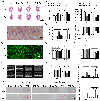Ranolazine prevents pressure overload-induced cardiac hypertrophy and heart failure by restoring aberrant Na+ and Ca2+ handling
- PMID: 30488495
- PMCID: PMC6515545
- DOI: 10.1002/jcp.27791
Ranolazine prevents pressure overload-induced cardiac hypertrophy and heart failure by restoring aberrant Na+ and Ca2+ handling
Abstract
Background: Cardiac hypertrophy and heart failure are characterized by increased late sodium current and abnormal Ca2+ handling. Ranolazine, a selective inhibitor of the late sodium current, can reduce sodium accumulation and Ca 2+ overload. In this study, we investigated the effects of ranolazine on pressure overload-induced cardiac hypertrophy and heart failure in mice.
Methods and results: Inhibition of late sodium current with the selective inhibitor ranolazine suppressed cardiac hypertrophy and fibrosis and improved heart function assessed by echocardiography, hemodynamics, and histological analysis in mice exposed to chronic pressure overload induced by transverse aortic constriction (TAC). Ca2+ imaging of ventricular myocytes from TAC mice revealed both abnormal SR Ca 2+ release and increased SR Ca 2+ leak. Ranolazine restored aberrant SR Ca 2+ handling induced by pressure overload. Ranolazine also suppressed Na + overload induced in the failing heart, and restored Na + -induced Ca 2+ overload in an sodium-calcium exchanger (NCX)-dependent manner. Ranolazine suppressed the Ca 2+ -dependent calmodulin (CaM)/CaMKII/myocyte enhancer factor-2 (MEF2) and CaM/CaMKII/calcineurin/nuclear factor of activated T-cells (NFAT) hypertrophy signaling pathways triggered by pressure overload. Pressure overload also prolonged endoplasmic reticulum (ER) stress leading to ER-initiated apoptosis, while inhibition of late sodium current or NCX relieved ER stress and ER-initiated cardiomyocyte apoptosis.
Conclusions: Our study demonstrates that inhibition of late sodium current with ranolazine improves pressure overload-induced cardiac hypertrophy and systolic and diastolic function by restoring Na+ and Ca 2+ handling, inhibiting the downstream hypertrophic pathways and ER stress. Inhibition of late sodium current may provide a new treatment strategy for cardiac hypertrophy and heart failure.
Keywords: Ca2+ transient; Heart failure; INa,L; hypertrophy; ranolazine.
© 2018 Wiley Periodicals, Inc.
Figures








Similar articles
-
Enhanced late INa induces proarrhythmogenic SR Ca leak in a CaMKII-dependent manner.J Mol Cell Cardiol. 2014 Nov;76:94-105. doi: 10.1016/j.yjmcc.2014.08.016. Epub 2014 Aug 27. J Mol Cell Cardiol. 2014. PMID: 25173923
-
Inhibition of the late sodium current slows t-tubule disruption during the progression of hypertensive heart disease in the rat.Am J Physiol Heart Circ Physiol. 2013 Oct 1;305(7):H1068-79. doi: 10.1152/ajpheart.00401.2013. Epub 2013 Jul 19. Am J Physiol Heart Circ Physiol. 2013. PMID: 23873796 Free PMC article.
-
Polydatin attenuates cardiac hypertrophy through modulation of cardiac Ca2+ handling and calcineurin-NFAT signaling pathway.Am J Physiol Heart Circ Physiol. 2014 Sep 1;307(5):H792-802. doi: 10.1152/ajpheart.00017.2014. Epub 2014 Jul 11. Am J Physiol Heart Circ Physiol. 2014. PMID: 25015961
-
Role of oxidants on calcium and sodium movement in healthy and diseased cardiac myocytes.Free Radic Biol Med. 2013 Oct;63:338-49. doi: 10.1016/j.freeradbiomed.2013.05.035. Epub 2013 Jun 1. Free Radic Biol Med. 2013. PMID: 23732518 Review.
-
New treatment options for late Na current, arrhythmias, and diastolic dysfunction.Curr Heart Fail Rep. 2012 Sep;9(3):183-91. doi: 10.1007/s11897-012-0099-3. Curr Heart Fail Rep. 2012. PMID: 22767404 Free PMC article. Review.
Cited by
-
ER stress and calcium-dependent arrhythmias.Front Physiol. 2022 Nov 8;13:1041940. doi: 10.3389/fphys.2022.1041940. eCollection 2022. Front Physiol. 2022. PMID: 36425292 Free PMC article. Review.
-
Chromatin compartment dynamics in a haploinsufficient model of cardiac laminopathy.J Cell Biol. 2019 Sep 2;218(9):2919-2944. doi: 10.1083/jcb.201902117. Epub 2019 Aug 8. J Cell Biol. 2019. PMID: 31395619 Free PMC article.
-
Virtual drug screen reveals context-dependent inhibition of cardiomyocyte hypertrophy.Br J Pharmacol. 2023 Nov;180(21):2721-2735. doi: 10.1111/bph.16163. Epub 2023 Jul 5. Br J Pharmacol. 2023. PMID: 37302817 Free PMC article.
-
Potential of natural drug modulation of endoplasmic reticulum stress in the treatment of myocardial injury.J Pharm Anal. 2024 Nov;14(11):101034. doi: 10.1016/j.jpha.2024.101034. Epub 2024 Jul 2. J Pharm Anal. 2024. PMID: 39720623 Free PMC article. Review.
-
Cardiac Late Sodium Channel Current Is a Molecular Target for the Sodium/Glucose Cotransporter 2 Inhibitor Empagliflozin.Circulation. 2021 Jun;143(22):2188-2204. doi: 10.1161/CIRCULATIONAHA.121.053350. Epub 2021 Apr 9. Circulation. 2021. PMID: 33832341 Free PMC article.
References
-
- Brill DM, and Wasserstrom JA. 1986. Intracellular sodium and the positive inotropic effect of veratridine and cardiac glycoside in sheep Purkinje fibers. Circulation research. 58:109–119. - PubMed
-
- Chaitman BR 2004. Efficacy and safety of a metabolic modulator drug in chronic stable angina: review of evidence from clinical trials. Journal of cardiovascular pharmacology and therapeutics. 9 Suppl 1:S47–64. - PubMed
-
- Chelu MG, Sarma S, Sood S, Wang S, van Oort RJ, Skapura DG, Li N, Santonastasi M, Muller FU, Schmitz W, Schotten U, Anderson ME, Valderrabano M, Dobrev D, and Wehrens XH. 2009. Calmodulin kinase II-mediated sarcoplasmic reticulum Ca2+ leak promotes atrial fibrillation in mice. The Journal of clinical investigation. 119:1940–1951. - PMC - PubMed
-
- Cingolani OH, Yang XP, Cavasin MA, and Carretero OA. 2003. Increased systolic performance with diastolic dysfunction in adult spontaneously hypertensive rats. Hypertension. 41:249–254. - PubMed
Publication types
MeSH terms
Substances
Grants and funding
LinkOut - more resources
Full Text Sources
Medical
Research Materials
Miscellaneous

